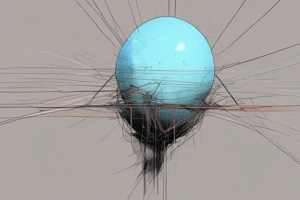Podcast
Questions and Answers
What is the definition of friction as it relates to static electricity?
What is the definition of friction as it relates to static electricity?
Static electricity generated by rubbing two materials together.
What is the key point to remember about friction in relation to creating static electricity?
What is the key point to remember about friction in relation to creating static electricity?
The materials involved must be different.
Explain how static electricity is generated by friction.
Explain how static electricity is generated by friction.
When two different materials are rubbed together, electrons move from one material to the other. One material gains electrons and becomes negatively charged, while the other loses electrons and becomes positively charged.
Give an example of static electricity created by friction.
Give an example of static electricity created by friction.
What is the definition of conduction in relation to static electricity?
What is the definition of conduction in relation to static electricity?
Explain how static electricity is transferred through conduction.
Explain how static electricity is transferred through conduction.
Give an example of static electricity transferred through conduction.
Give an example of static electricity transferred through conduction.
What is the key point to remember about conduction in relation to static electricity?
What is the key point to remember about conduction in relation to static electricity?
Explain how static electricity is created through induction.
Explain how static electricity is created through induction.
Give an example of static electricity created through induction.
Give an example of static electricity created through induction.
Which method of static electricity generation requires direct contact between objects?
Which method of static electricity generation requires direct contact between objects?
Which of the following is NOT a key point to remember about static electricity generation methods?
Which of the following is NOT a key point to remember about static electricity generation methods?
Flashcards
Friction Static Electricity
Friction Static Electricity
Static electricity created when two different materials are rubbed together, causing electron transfer.
Electron Transfer (Friction)
Electron Transfer (Friction)
Electrons move from one material to another during friction, creating opposite charges.
Static Electricity (Definition)
Static Electricity (Definition)
A stationary electric charge on an object.
Charged Object
Charged Object
Signup and view all the flashcards
Conduction (Static)
Conduction (Static)
Signup and view all the flashcards
Conduction (Electricity)
Conduction (Electricity)
Signup and view all the flashcards
Induction (Static Electricity)
Induction (Static Electricity)
Signup and view all the flashcards
Induction - Charge Redistribution
Induction - Charge Redistribution
Signup and view all the flashcards
Neutral Object
Neutral Object
Signup and view all the flashcards
Static Charge Types
Static Charge Types
Signup and view all the flashcards
Materials for Friction
Materials for Friction
Signup and view all the flashcards
Difference between Conduction and Induction
Difference between Conduction and Induction
Signup and view all the flashcards
Electric Charge
Electric Charge
Signup and view all the flashcards
Electron Movement (Conduction)
Electron Movement (Conduction)
Signup and view all the flashcards
Static Shock Example
Static Shock Example
Signup and view all the flashcards
Static Electricity Usefulness
Static Electricity Usefulness
Signup and view all the flashcards
Effects of Static Electricity
Effects of Static Electricity
Signup and view all the flashcards
Charge Transfer
Charge Transfer
Signup and view all the flashcards
Materials Needed for Static
Materials Needed for Static
Signup and view all the flashcards
Electron Movement (Induction)
Electron Movement (Induction)
Signup and view all the flashcards
Study Notes
Static Electricity: Methods of Transfer
-
Friction: Static electricity is generated when two different materials are rubbed together. Electrons transfer from one material to the other, causing one material to become negatively charged and the other positively charged.
-
Example: Rubbing a balloon on hair – the balloon gains electrons and becomes negatively charged, while the hair loses electrons and becomes positively charged.
-
Key Principle: Different materials are needed for friction to generate static electricity.
Conduction
-
Definition: Transfer of static electricity through direct contact between a charged and uncharged object.
-
Mechanism: Electrons move from the charged object to the neutral object, redistributing the charge. This transfer changes the charge of both objects, the type depending on the initial charge.
-
Example: Touching a doorknob after walking across a carpet – excess charge transfers, causing a shock.
-
Key Point: Physical contact is essential for conduction.
Induction
-
Definition: Static electricity generation without direct contact, caused by the presence of a charged object close to an uncharged object.
-
Method: A charged object causes a redistribution of electrons within the neutral object. This separation of charge creates regions of positive and negative charge near the charged object, without actually transferring electrons to or from the neutral object.
-
Example: Bringing a charged balloon near a wall. Electrons in the wall move, creating a negative side near the balloon and a positive side on the opposite wall.
-
Key Principle: No physical contact is required; proximity is enough to cause induction.
Studying That Suits You
Use AI to generate personalized quizzes and flashcards to suit your learning preferences.




